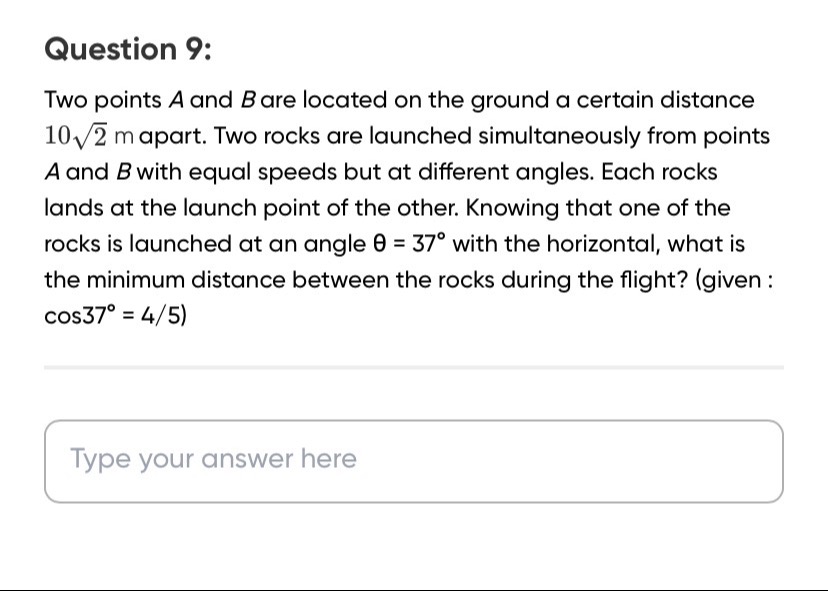Question
Question: Two points A and B are located on the ground a certain distance $10\sqrt{2}$ m apart. Two rocks are ...
Two points A and B are located on the ground a certain distance 102 m apart. Two rocks are launched simultaneously from points A and B with equal speeds but at different angles. Each rocks lands at the launch point of the other. Knowing that one of the rocks is launched at an angle θ=37∘ with the horizontal, what is the minimum distance between the rocks during the flight? (given: cos37° = 4/5)

2 m
4 m
6 m
8 m
2 m
Solution
The problem describes a scenario of projectile motion where two rocks are launched simultaneously from points A and B, with a distance R=102 m between them. Both rocks are launched with the same initial speed v0 but at different angles. Crucially, each rock lands at the launch point of the other. This implies that the horizontal range of both projectiles is equal to the distance R.
Let the launch angles be θ1 and θ2. The horizontal range R of a projectile launched with speed v0 at an angle θ is given by the formula: R=gv02sin(2θ)
Since both rocks have the same range R and the same initial speed v0, we have: gv02sin(2θ1)=gv02sin(2θ2) This simplifies to sin(2θ1)=sin(2θ2). Given that the angles are different, the relationship between them must be 2θ1=180∘−2θ2, which leads to θ1+θ2=90∘.
We are given that one of the rocks is launched at an angle θ1=37∘. Therefore, the other launch angle is θ2=90∘−37∘=53∘.
We are also given cos(37∘)=4/5. From this, we can deduce sin(37∘)=1−(cos(37∘))2=1−(4/5)2=1−16/25=9/25=3/5. Using the complementary angle identities, sin(53∘)=cos(37∘)=4/5 and cos(53∘)=sin(37∘)=3/5.
Now, let's set up a coordinate system. Let point A be the origin (0, 0) and point B be at (R,0).
The position of the rock launched from A (Rock 1) at time t is: x1(t)=v0cos(θ1)t=v0cos(37∘)t=54v0t y1(t)=v0sin(θ1)t−21gt2=v0sin(37∘)t−21gt2=53v0t−21gt2
The rock launched from B (Rock 2) starts at (R,0) and travels towards A. Its position at time t is: x2(t)=R−v0cos(θ2)t=R−v0cos(53∘)t=R−53v0t y2(t)=v0sin(θ2)t−21gt2=v0sin(53∘)t−21gt2=54v0t−21gt2
The time of flight for Rock 1 is T1=g2v0sin(θ1)=g2v0(3/5)=5g6v0. The time of flight for Rock 2 is T2=g2v0sin(θ2)=g2v0(4/5)=5g8v0. Since T1<T2, both rocks are in flight during the interval [0,T1].
We are interested in the distance between the rocks. Let's find the difference in their coordinates: Δx(t)=x1(t)−x2(t)=54v0t−(R−53v0t)=(54+53)v0t−R=57v0t−R Δy(t)=y1(t)−y2(t)=(53v0t−21gt2)−(54v0t−21gt2)=(53−54)v0t=−51v0t
The square of the distance between the rocks is d(t)2=(Δx(t))2+(Δy(t))2: d(t)2=(57v0t−R)2+(−51v0t)2 d(t)2=(2549v02t2−2⋅57v0tR+R2)+251v02t2 d(t)2=2550v02t2−514v0Rt+R2 d(t)2=2v02t2−514v0Rt+R2
This is a quadratic equation in t of the form at2+bt+c, where a=2v02, b=−514v0R, and c=R2. The minimum value of this quadratic occurs at tmin=−b/(2a). tmin=−(−514v0R)/(2⋅2v02)=5⋅4v0214v0R=20v014R=10v07R
To ensure this minimum occurs during the flight, we compare tmin with T1. We need to find v0. The range R is given by R=gv02sin(2θ1). 102=gv02sin(2×37∘)=gv02sin(74∘) sin(74∘)=2sin(37∘)cos(37∘)=2×(3/5)×(4/5)=24/25. So, 102=gv02(24/25), which means gv02=24102×25=242502=121252.
Now, let's express T1 in terms of R and v0: T1=5g6v0. We can write g=Rv02(24/25). T1=5(Rv02(24/25))6v0=5v02(24/25)6v0R=5v0(24/25)6R=v0(120/25)6R=v0(24/5)6R=24v030R=4v05R.
Comparing tmin and T1: tmin=10v07R T1=4v05R=10v012.5R Since 10v07R<10v012.5R, the minimum distance occurs within the flight time of both rocks.
Now, substitute tmin back into the equation for d(t)2: dmin2=2v02(10v07R)2−514v0R(10v07R)+R2 dmin2=2v02100v0249R2−5098R2+R2 dmin2=10098R2−5098R2+R2 dmin2=5049R2−5098R2+5050R2 dmin2=50(49−98+50)R2=501R2
The minimum distance dmin is the square root of dmin2: dmin=50R2=50R=52R
Finally, substitute the given value of R=102 m: dmin=52102 m=2 m
The minimum distance between the rocks during the flight is 2 m.
